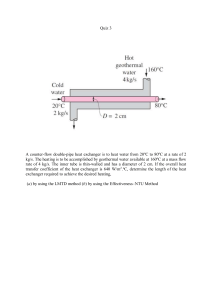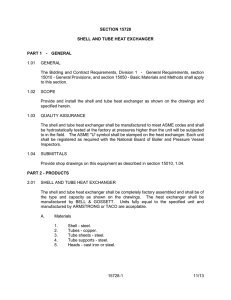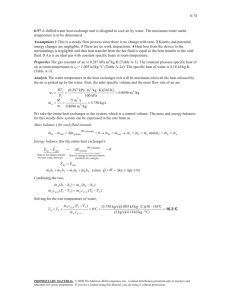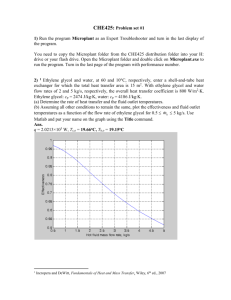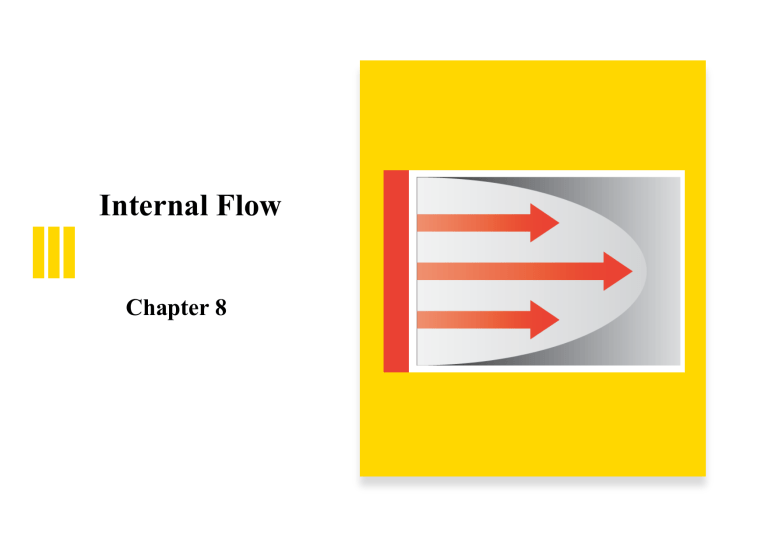
Internal Flow Chapter 8 General Considerations • • • General Considerations Many different flow patterns: laminar and turbulent, entrance and fully developed flow. We may also need to consider two phase (liquid with gas bubbles inside) flow. Difference in flow patterns leads to large difference in rate of convective heat transfer. 2 Entrance Conditions Thermal Boundary Layer in a tube • Thermal Effects: Assume laminar flow with uniform temperature, T ( r,0 ) = Ti , at inlet of circular tube with uniform surface temperature, Ts ¹ Ti , or heat flux, qs¢¢ . • Two different boundary conditions: • Thermal entry length æ x fd ,t Laminar flow: çç è D ö ÷÷ » 0.05 Re D Pr ølam Turbulent Flow: 10 < ( x fd ,t / D ) < 60 3 Entry Lengths Thermal Entry Lengths • Entry lengths depend on whether the flow is laminar or turbulent, which, in turn, depends on Reynolds number. ReD º r um Dh µ The hydraulic diameter is defined as in which case, ReD º For a circular tube, Dh º 4 Ac P r um Dh 4 m! = µ Pµ ReD = r um D 4 m! = µ p Dµ • Onset of turbulence occurs at a critical Reynolds number of ReD ,c » 2300 • Fully turbulent conditions exist for ReD » 10,000 4 Two types of common boundary conditions 1. Constant surface heat flux: Tube wall is heated electrically or outer surface is uniformly irradiated qs" = constant 2. Constant surface temperature: Phase change (boiling or condensation) at the outer surface Ts = constant § For uniform surface heat flux and constant surface temperature, what may be said about the change in the temperature profile with increasing x? 5 Mean Quantities The Mean Temperature (Tm in r direction) • Temperature in tube at any cross-section is not uniform Thermal energy transfer rate: E! t = ò Ac r uc pT dAc º m! c pTm Hence, Tm = ò Ac r uc pT dAc m! c p External flow: Internal flow: ( u¥ ) (T¥ ) ( um ) (Tm ) • For incompressible, constant-property flow in a circular tube, 2 Tm = 2 um ro ro ò u ( x, r ) T ( x, r ) r dr 0 • Newton’s law of cooling for the Local Heat Flux: qs¢¢ = h (Ts - Tm ) • The mean temperature Tm is a convenient reference temperature for internal flows, playing the same role as the free stream temperature T∞ for external flows. T∞ is a constant in the flow direction. However Tm varies with x, i.e. dTm/dx is non-zero. 6 Temperature variation in x direction Tm(x) • Fluid velocity in developed region: ¶u =0 ¶x • Fluid temperature in developed region: dT (r , x) ¹0 ¶x • But the relative shape of the T profile no longer changes with x: dTm ( x) ¹0 dx ¶ é Ts ( x ) - T ( r , x ) ù ê ú =0 ¶x ë Ts ( x ) - Tm ( x ) û fd ,t 7 Fully Developed Flow (cont.) • Requirement for fully developed thermal conditions: ¶ é Ts ( x ) - T ( r , x ) ù ê ú =0 ¶x ë Ts ( x ) - Tm ( x ) û fd ,t • The derivative of this ratio with respect to r must also be independent of x: - ¶T / ¶r r = r ¶ æ Ts - T ö o = ¹ f ( x) ç ÷ ¶r è Ts - Tm ø r =r Ts - Tm Variation of h in entrance o and fully developed regions: • Local convection coefficient: qs" = -k ¶T (r , x) = h[Ts ( x) - Tm ( x)] ¶r r = r0 Hence, assuming constant properties, qs¢¢ / k h = ¹ f ( x) Ts - Tm k h ¹ f ( x) 8 Mean Temperature Determination of the Mean Temperature • Determination of Tm ( x ) is an essential feature of an internal flow analysis. Determination begins with an energy balance for a differential control volume. ! p éë(Tm + dTm ) - Tm ùû = mc ! p dTm dqconv = mc Integrating from the tube inlet to outlet, qconv = m! c p (Tm ,o - Tm ,i ) (1) 9 Mean Temperature (cont.) A differential equation from which Tm ( x ) may be determined is obtained by substituting for dqconv = qs¢¢ ( P dx ) = h (Ts - Tm ) P dx. dTm qs¢¢P P = = h (Ts - Tm ) dx m! c m! cp p (2) • Special Case 1: Uniform Surface Heat Flux dTm qs¢¢P = ¹ f ( x) dx m! c p Tm ( x ) = Tm ,i + qs¢¢P m! cp T x Why does the surface temperature vary with x as shown in the figure? In principle, what value does Ts assume at x=0? Total heat rate: qconv = qs¢¢ PL 10 Mean Temperature (cont.) • Special Case 2: Uniform Surface Temperature From Eq. (2), with DT º Ts - Tm d ( DT ) d Tm P == h DT dx dx m! cp Integrating from x=0 to any downstream location, æ ö Ts - Tm ( x ) Px hx ÷ = exp ç ç m! c ÷ Ts - Tm ,i p è ø 1 x hx = ò 0 hx dx x Overall Conditions: x æ ö æ DTo Ts - Tm ,o h As PL = = exp ç h ÷ = exp ç ç m! c ÷ ç m! c DTi Ts - Tm ,i p p è ø è qconv = m! c p (Tm ,o - Tm ,i ) DT!m = DTo - DTi 1n ( DTo / DTi ) qconv = h As DT!m ö ÷ ÷ ø (1) ( 3) 11 Mean Temperature (cont.) How to calculate total heat transfer rate to a fluid flowing in a tube Method 1: if the mass flow rate and thermal properties of the fluid is know. qconv = m! c p (Tm ,o - Tm ,i ) Method 2: if the mass flow rate or cp is unknown. Case 1: uniform surface heat flux qconv = qs"pDL Case 2: uniform surface temperature qconv = h pDLDTlm 12 Mean Temperature (cont.) • Special Case 3: Uniform External Fluid Temperature æ ö æ ö DTo T¥ - Tm ,o U A 1 s ÷ ÷ = = exp ç = exp ç ç m! c ÷ ç m! c R ÷ DTi T¥ - Tm ,i p p tot ø è ø è q = UAs DT!m DT!m = Rtot Ū is the average overall heat transfer coefficient (ŪAs)-1 is the total thermal resistance between the two fluids DT!m ® Eq. (3) with Ts replaced by T¥ . Note: Replacement of T¥ by Ts,o if outer surface temperature is uniform. 13 Heat Transfer Correlations Heat Transfer Correlations for Fully Developed Flow • Laminar Flow in a Circular Tube: The local Nusselt number is constant throughout the fully developed region, but its value depends on the surface thermal condition. NuD = hD = 4.36 k (8.53) – Uniform Surface Temperature (Ts ): NuD = hD = 3.66 k (8.55) – Uniform Surface Heat Flux ( qs¢¢) : • Turbulent Flow in a Circular Tube: – For a smooth surface and fully turbulent conditions ( ReD > 10,000 ) , the Dittus – Boelter equation may be used as a first approximation: n = 0.3 ( Ts < Tm ) NuD = 0.023ReD4/5 Pr n (8.60) n = 0.4 ( Ts > Tm ) – The effects of wall roughness and transitional flow conditions ( ReD > 3000 ) may be considered by using the Gnielinski correlation: ( f / 8)( ReD - 1000 ) Pr NuD = 1/2 (8.62) 1 + 12.7 ( f / 8 ) ( Pr 2/3 - 1) f: friction factor for smooth pipe wall; f = (0.790 ln Re D - 1.64 ) -2 14 Fully Developed Flow (cont.) Heat Transfer Correlations for Fully Developed Flow • Noncircular Tubes: – Use of hydraulic diameter as characteristic length: Dh º 4 Ac P – Since the local convection coefficient varies around the periphery of a tube, approaching zero at its corners, correlations for the fully developed region are associated with convection coefficients averaged over the periphery of the tube. – Laminar Flow: The local Nusselt number is a constant whose value (Table 8.1) depends on the surface thermal condition ( Ts or qs¢¢ ) and the duct aspect ratio. – Turbulent Flow: As a first approximation, the Dittus-Boelter or Gnielinski correlation may be used with the hydraulic diameter, irrespective of the surface thermal condition. 15 16 Annulus The Concentric Tube Annulus • Fluid flow through region formed by concentric tubes. • Convection heat transfer may be from or to inner surface of outer tube and outer surface of inner tube. • Surface thermal conditions may be characterized by uniform temperature ( Ts ,i , Ts ,o ) or uniform heat flux ( qi¢¢, qo¢¢ ) . • Convection coefficients are associated with each surface, where qi¢¢ = hi (Ts ,i - Tm ) qo¢¢ = ho (Ts ,o - Tm ) Annulus (cont.) Nui º hi Dh k Nuo º ho Dh k Dh = Do - Di • Fully Developed Laminar Flow Nusselt numbers depend on Di / Do and surface thermal conditions (Tables 8.2, 8.3) • Fully Developed Turbulent Flow Correlations for a circular tube may be used with D replaced by Dh . Heat Transfer Enhancement • Introduce surface roughness to enhance turbulence or secondary flow Schematic of helically coiled tube and secondary flow in enlarged cross-sectional view. 19 Example 1 Example 1: heat transfer in blood flow In the human body, blood flows from the heart into a series of branching blood vessels having successively smaller diameters. The diameters and average blood velocities for three different types of vessels are given in the table. Assuming blood enters the vessel at the arterial temperature and exits at the temperature of the surrounding tissue. Estimate the length required for the mean blood temperature to closely approach the tissue temperature, specifically, to satisfy (Tt – Tm,o)/(Tt – Tm,i) = 0.05 for each of the vessel. From the results, determine where the blood temperature is equilibrated with the tissue temperature. Heat transfer between vessel wall and surrounding tissue can be described by an effective heat transfer coefficient, ht = kt/D, where kt = 0.5 W m-1 K-1. Approximate blood as water at 310 K, i.e. ρ = 993 kg m-3, cp = 4178 J kg-1 K-1, μ = 695×10-6 Pa∙s, k = 0.628 W m-1 K-1, Pr = 4.62. 20 Example 1 Example 1: heat transfer in blood flow Solution: Large artery • ReD = ρumD/μ = 557, so the flow is laminar • It is neither constant surface temperature nor constant surface heat flux. Assume Nu ~ 4, we have hb ~ 4kb/D • Ignoring the thermal resistance of the vessel wall, so the overall heat transfer coefficient is: 1 1 1 D D = + = + = 7.2 ´10 -3 m 2 K W -1 U hb ht 4kb kt æ ö DTo T¥ - Tm ,o U A s ÷ = = exp ç ç m! c ÷ DTi T¥ - Tm ,i p ø è Special case 3: uniform external T m! = rumpD 2 / 4 rum Dc p æ Tt - Tm ,o ö ÷ = 8.7 m lnçç L=÷ 4U è Tt - Tm ,i ø x fd ,t = 0.05 Re D D Pr » 0.4 m So the flow becomes fully developed well within the length of 8.7m. 21 Example 1 Example 1: heat transfer in blood flow Solution (cont’d): Repeat for the other two cases: • The large value of L for the large artery: the Tb remains close to the inlet arterial blood temperature. • In the intermediate arterioles (millimeters in length), the Tb approaches the Tt within a length on the order of 10 μm. The Tb exiting them and entering the capillaries would be approximately equal to the Tt. • There could then be no further temperature drop in the capillaries. Conclusion: it is in the arterioles and slightly larger vessels in which the blood temperature equilibrates to the tissue temperature. 22 Example 2 Example 2: heat exchanger Air flowing in a rectangular duct I is to be heated by steam condensing in duct II. The wall separating the two ducts is at uniform temperature of 38 °C. The inlet and outlet bulk temperature of the air are 24 °C and 26 °C, respectively. It may be assumed that the external surface of the entire heat exchanger is perfectly insulated. The mass flow rate of air is 0.053 kg s-1, ν = 1.57×10-5 m2 s-1, k = 0.0263 W m-1 K-1, cp = 1004.8 J kg1 K-1, Pr = 0.708. (a) Calculate the heat transfer coefficient for the airflow. (b) Compute the value of q in two different ways. 23 Example 2 Example 2: heat exchanger Solution: First, find Reynolds number to see if the flow is laminar or turbulent. Noncircular tube: Dº 4 Ac 4 ´ 0.254 ´ 0.0127 = = 0.0242 m P 2 ´ (0.254 + 0.0127) Air velocity: Vº 0.053 m! = = 13.947 m s -1 rAc 1.178 ´ 0.254 ´ 0.0127 VD Re D º Turbulent flow f = (0.790 ln Re D - 1.64 ) = 0.0256 -2 Friction factor: Convection coefficient: n = 21498 Nu D º hD ( f / 8) Re D Pr = k 1.07 + 12.7( f / 8)1/ 2 (Pr 2 / 3 - 1) h = 57.5 W m -2 K -1 Heat transfer rate: qconv = h As DTlm = 115.6 W Where, As = WL or qconv = m! c p (Tm , 0 - Tm ,i ) = 106.5 W 24 Self test Tm = ò Ac ruTdAc m! 1. How is the mean temperature of a fluid flowing through a pipe or duct defined? 2. Water enters a circular tube whose walls are maintained at constant temperature at a specified flow rate and temperature. For fully developed turbulent flow, the Nusselt number can be determined from Nu = 0.023 Re0.8 Pr0.4. What is the correct temperature difference to use in Newton’s law of cooling? (the log mean temperature difference) 3. Air (cp = 1007 J kg-1 K-1) enters a 17 cm diameter and 4 m long tube at 65 °C at a rate of 0.08 kg/s and leaves at 15 °C. The tube is observed to be nearly isothermal at 5 °C. What is the average convective heat transfer coefficient? (67.56 W m-2 K-1) 4. Water enters a 5 mm diameter and 13 m long tube at 45 °C with a velocity of 0.3 m s-1. The tube is maintained at a constant temperature of 8 °C. What is the exit temperature of water? For water, use k = 0.607 W m-1 K-1, Pr = 6.14, ν =0.894×10-6 m2 s-1, cp = 4180 J kg-1 K-1, ρ = 997 kg m-3. (8.9 °C) 25 Heat Exchangers Chapter 11 Heat transfer applications in chemical industry • Chemical reactions (supply or dissipate heat) – Combustion, gasification, pyrolysis, polymerisation, smelting of ores, alloying of metals, sintering, firing of ceramics, glazes and coating • Biological reactions – Cooling and freezing of foodstuffs, pasterisation, fermentation, brewing, baking • Physical changes – Purification, separation, evaporation, drying, condensation, melting, crystallization, casting, forging, rolling, powder and fiber production • Power generation (power cycles) • Air conditioning and space heating • Waste heat recovery 27 Unit operations in heat transfer processes • The study of process engineering is an attempt to combine all forms of physical processing into a small number of basic operations, which are called unit operations • Unit operations in heat transfer: 1) Thermal insulation (prevent heat transfer, k, Rcritical) 2) Increase heat transfer (Fins) 3) T measurement instruments (Thermocouples, thermometers, resistance temperature detector (RTD), IR) 4) Heat recovery and integration - heat exchanger 28 Insulation materials • Common heat insulation materials: (low k) 1. Minerals: alumina (Al2O3), glass, rock, silica (SiO2), slag, and vermiculite 2. Organic matters: cane, cotton, wood, cork. 3. Plastics: elastomer, polystyrene, polyisocyanate. 4. Cements. 5. Heat-reflecting metals: aluminium, nickel, stainless steel (radiant barrier) • Finishes: – Thermal insulations require an external covering (finish) to provide protection against entry of water or process fluids, mechanical damage, and ultraviolet degradation of foamed materials. • Selection of insulation components depends on the purpose for which the system is to be used. Cryogenic (-273 ~ -101°C), low temperature (-101 ~ 1°C), moderate or high temperature. Critical insulation radius is also another consideration. 29 Thermocouples Thermocouples • What is a thermocouple sensor? o A thermocouple is a sensor for measuring temperature. It consists of two dissimilar metals, joined together at one end. When the junction of the two metals is heated or cooled a voltage is produced (thermal electric effect or Seeback effect) that can be correlated back to the temperature. Type K thermal couple • What are the different thermocouple types? o A thermocouple is available in different combinations of metals or calibrations. The four most common calibrations are J, K, T and E. There are high temperature calibrations R, S, C and GB. Each calibration has a different temperature range and environment. The maximum range is also limited by the diameter of the thermocouple wire, i.e., a very thin thermocouple may not reach the full temperature range. 30 Types Different types of thermocouples http://www.omega.com/temperature/ 31 Types Heat Exchanger Types Heat exchangers are ubiquitous in energy conversion and utilization. They involve heat exchange between two fluids separated by a solid and encompass a wide range of flow configurations. • Concentric-Tube Heat Exchangers Parallel Flow Counterflow Ø Simplest configuration. Ø Superior performance associated with counter flow. 32 Types (cont.) • Cross-flow Heat Exchangers Finned-Both Fluids Unmixed Unfinned-One Fluid Mixed the Other Unmixed Ø For cross-flow over the tubes, fluid motion, and hence mixing, in the transverse direction (y) is prevented for the finned tubes, but occurs for the unfinned condition. Ø Heat exchanger performance is influenced by mixing. 33 Types (cont.) • Shell-and-Tube Heat Exchangers One Shell Pass and One Tube Pass Ø Baffles are used to establish a cross-flow and to induce turbulent mixing of the shell-side fluid, both of which enhance convection. Ø The number of tube and shell passes may be varied, e.g.: One Shell Pass, Two Tube Passes Two Shell Passes, Four Tube Passes 34 Industrial Shell-and-Tube Heat Exchanger Designs 35 Types (cont.) • Compact Heat Exchangers Ø Widely used to achieve large heat rates per unit volume, particularly when one or both fluids is a gas. Ø Characterized by large heat transfer surface areas per unit volume, small flow passages, and laminar flow. (a) (b) (c) (d) (e) Fin-tube (flat tubes, continuous plate fins) Fin-tube (circular tubes, continuous plate fins) Fin-tube (circular tubes, circular fins) Plate-fin (single pass) Plate-fin (multipass) 36 Overall Coefficient Overall Heat Transfer Coefficient • An essential requirement for heat exchanger design or performance calculations. • Contributing factors include convection and conduction associated with the two fluids and the intermediate solid, as well as the potential use of fins on both sides and the effects of time-dependent surface fouling. Mean temperature difference Surface area DTm q = ò U (T1 - T2 )dA = = UADTm Rt A Thermal resistance U= Overall heat transfer coefficient 1 Rt A DTm Rt = q 37 Overall Coefficient (cont.) Overall Heat Transfer Coefficient • With subscripts c and h used to designate the cold and hot fluids, respectively, the most general expression for the overall coefficient is: R¢¢f ,c R¢¢f ,h 1 1 1 = 1 = 1 = + + Rw + + (11.1b) hA A A hA h h h h ( ) ( ) ( ) ( ) UA (UA)c (UA)h o o o o c c h h 2 Ø R¢¢f ® Fouling factor for a unit surface area (m × K/W) ® Table 11.1 Ø Rw ® Wall conduction resistance (K/W) Ø ho ® Overall surface efficiency of fin array (Section 3.6.5) æ Af ö ho,c or h = ç1 - (1 - h f ) ÷ A = At ® total surface area (fins and exposed base) A è øc or h A ® surface area of fins only f æ tanh ( mL ) ö mL ÷øc or h è Ø Assuming an adiabatic tip, the fin efficiency is h f ,c or h = ç • For the unfinned, tubular heat exchangers, (11.5) 38 Overall Coefficient (cont.) Fouling Factor • Fouling in heat exchangers will increase overall thermal resistance, increase energy consumption and decrease effectiveness of heat exchangers. Fouling factor, depends on fluid impurities, operating temperature, fluid velocity, structure of heat exchangers and servicing arrangement. 39 LMTD Method A Methodology for Heat Exchanger Design Calculations - The Log Mean Temperature Difference (LMTD) Method • A form of Newton’s law of cooling may be applied to heat exchangers by using a log-mean value of the temperature difference between the two fluids: q = U A DT!m DT!m = DT1 - DT2 1n ( DT1 / DT2 ) Evaluation of DT1 and DT2 depends on the heat exchanger type. • Counter-Flow Heat Exchanger: DT1 º Th ,1 - Tc ,1 = Th ,i - Tc ,o DT2 º Th ,2 - Tc ,2 = Th ,o - Tc ,i 40 LMTD Method (cont.) • Parallel-Flow Heat Exchanger: DT1 º Th ,1 - Tc ,1 = Th ,i - Tc ,i DT2 º Th ,2 - Tc ,2 = Th ,o - Tc ,o Ø Note that Tc,o cannot exceed Th,o for a PF HX, but can do so for a CF HX. Ø For equivalent values of UA and inlet temperatures, DT!m ,CF > DT!m ,PF • Shell-and-Tube and Cross-Flow Heat Exchangers: DT!m = F DT!m ,CF F ® Figures 11S.1 - 11S.4 41 LMTD Method (cont.) Shell-and-Tube and Cross-Flow Heat Exchangers 42 LMTD Method (cont.) Shell-and-Tube and Cross-Flow Heat Exchangers 43 LMTD Method (cont.) Shell-and-Tube and Cross-Flow Heat Exchangers 44 LMTD Method (cont.) Shell-and-Tube and Cross-Flow Heat Exchangers 45 Energy Balance Overall Energy Balance • Application to the hot (h) and cold (c) fluids: • Assume negligible heat transfer between the exchanger and its surroundings and negligible potential and kinetic energy changes for each fluid. × q = m h ( ih ,i - ih ,o ) q = m c ( ic ,o - ic ,i ) × i ® fluid enthalpy • Assuming no liquid-vapor phase change and constant specific heats, q = m h c p ,h (Th ,i - Th ,o ) = Ch (Th ,i - Th ,o ) × q = m c c p ,c (Tc ,o - Tc ,i ) = Cc (Tc ,o - Tc ,i ) × Ch , Cc ® Heat capacity rates 46 Special Conditions Special Operating Conditions Ø Case (a): Ch>>Cc or h is a condensing vapor ( Ch ® ¥ ) . – Negligible or no change in Th (Th ,o = Th ,i ) . Ø Case (b): Cc>>Ch or c is an evaporating liquid ( Cc ® ¥ ) . – Negligible or no change in Tc (Tc ,o = Tc ,i ) . Ø Case (c): Ch=Cc. – DT1 = DT2 = DT!m 47 Example 3 Example 3: Counterflow, concentric tube heat exchanger A counterflow, concentric tube heat exchanger is used to cool the lubricating oil for a large industrial gas turbine engine. The flow rate of cooling water through the inner tube ( Di = 25 mm) is 0.2 kg/s, while the flow rate of oil through the outer annulus (Do = 45 mm) is 0.1 kg/s. The oil and water enter at temperatures of 100 and 30°C, respectively. How long must the tube be made if the outlet temperature of the oil is to be 60°C? 48 Example 3 Example 3: Counterflow, concentric tube heat exchanger Assumptions: 1. Negligible heat loss to the surroundings. 2. Negligible kinetic and potential energy changes. 3. Constant properties. 4. Negligible tube wall thermal resistance and fouling factors. 5. Fully developed conditions for the water and oil ( U independent of x). Solution: Heat transfer rate by overall energy balance: Water outlet temperature: The required heat exchanger length may now be obtained from where A = πDi L 49 Example 3 Example 3: Counterflow, concentric tube heat exchanger Solution (cont’d): For water flow through the tube, (turbulent flow) The convection coefficient 50 Example 3 Example 3: Counterflow, concentric tube heat exchanger Solution (cont’d): For the flow of oil through the annulus, the hydraulic diameter is Dh = Do − Di = 0.02 m, and the Reynolds number is (laminar flow) Table 8.2, with (Di /Do) = 0.56, linear interpolation provides The overall convection coefficient is then and from the rate equation it follows that 51 General Considerations General Considerations • Computational Features/Limitations of the LMTD Method: Ø The LMTD method may be applied to design problems for which the fluid flow rates and inlet temperatures, as well as a desired outlet temperature, are prescribed. For a specified heat exchanger type, the required size (surface area), as well as the other outlet temperature, are readily determined. Ø If the LMTD method is used in performance calculations for which both outlet temperatures must be determined from knowledge of the inlet temperatures, the solution procedure is iterative. Ø For both design and performance calculations, the effectiveness-NTU method may be used without iteration. 52 Definitions Definitions • Heat exchanger effectiveness, e : e= q qmax = Ch (Th ,in - Th ,out ) Cmin (Th ,in - Tc ,in ) = Cc (Tc ,out - Tc ,in ) Cmin (Th ,in - Tc ,in ) (11.19) 0 £ e £1 • Maximum possible heat rate: qmax = Cmin (Th ,i - Tc ,i ) Cmin (11.18) ìïCh if Ch < Cc = íor ïî Cc if Cc < Ch Ø Maximum rate of heat transfer is limited by the medium with the smaller heat capacity 53 Definitions (cont.) • Number of Transfer Units, NTU NTU º UA Cmin (11.24) Ø A dimensionless parameter widely used in heat exchanger designs. Its magnitude influences heat exchanger performance. q ­ with ­ NTU Ø Correlations between NTU and ε are tabulated plotted for heat exchanger designs. 54 HX Relations Heat Exchanger Relations ( ) ì ï • íor ï î q = m h ih ,i - ih ,o ì ï • íor ï î q = m c ( ic ,o - ic ,i ) × q = Ch (Th ,i - Th ,o ) × q = Cc (Tc ,o - Tc ,i ) q = e Cmin (Th ,i - Tc ,i ) • • Performance Calculations: Ø e = f ( NTU, Cmin / Cmax ) Cr Ø Relations ® Table 11.3 or Figs. 11.10 - 11.15 55 HX Relations Heat Exchanger Relations 56 HX Relations Heat Exchanger Relations 57 HX Relations Heat Exchanger Relations 58 HX Relations Heat Exchanger Relations 59 Example 4 Example 4: Finned-tube, cross-flow heat exchanger Hot exhaust gases, which enter a finned-tube, cross-flow heat exchanger at 300°C and leave at 100°C, are used to heat pressurized water at a flow rate of 1 kg/s from 35 to 125°C. The overall heat transfer coefficient based on the gas-side surface area is Uh = 100 W/m2·K. Determine the required gas-side surface area Ah using the NTU method. 60 Example 4 Example 4: Finned-tube, cross-flow heat exchanger Assumptions: 1. Negligible heat loss to the surroundings and kinetic and potential energy changes. 2. Constant properties. Properties: Solution: To determine the minimum heat capacity rate, we begin by computing Based on energy balance qmax can be determined: Actual heat transfer rate: 61 Example 4 Example 4: Finned-tube, cross-flow heat exchanger Solution (cont’d): 62 Heat exchanger calculation • Design calculation • Performance (rating) calculation mc, mh, Tc,i, and Th,i known Known heat exchanger type, size and fluid flow rate Objective: Design heat exchanger to provide desired Tc,o Objective: Performance q, Tc,o and Th,o Methods: Use energy balance to get q and Th,o LMTD, A Methods: NTU method get ε qmax q, Tc,o and Th,o 63 Self-test • The radiator in an automobile is a cross-flow heat exchanger (UAs = 10 kW/K) that uses air (cp = 1.00 kJ/kg∙K) to cool the engine coolant fluid (cp = 4.00 kJ/kg ∙ K). The engine fan draws 30 °C air through this radiator at a rate of 4 kg/s while the coolant pump circulates the engine coolant at a rate of 5 kg/s. The coolant enters this radiator at 80 °C. Under these conditions, what is the number of transfer units (NTU) of this radiator? (2.5) • Cold water (cp = 4.18 kJ/kg∙K) enters a counter-flow heat exchanger at 18 °C at a rate of 0.7 kg/s where it is heated by hot air (cp = 1.0 kJ/kg∙K) that enters the heat exchanger at 50 °C at a rate of 1.6 kg/s and leaves at 25 °C. What is the maximum possible outlet temperature of the cold water? (35.5 °C) • Hot water coming from the engine is to be cooled by ambient air in a car radiator. The aluminium tubes in which the water flows have a diameter of 4 cm and negligible thickness. Fins are attached on the outer surface of the tubes in order to increase the heat transfer surface area on the air side. The heat transfer coefficients on the inner and outer surfaces are 2000 and 150 W/m2∙K, respectively. If the effective surface area on the finned side is 12 times the inner surface area, what is the overall heat transfer coefficient of this heat exchanger based on the inner surface area? (947 W/m2∙K) 64 Tutorial 7 Q1. In the final stages of production, a pharmaceutical is sterilized by heating it from 25 to 75°C as it moves at 0.2 m/s through a straight thin‐walled stainless steel tube of 12.7‐mm diameter. A uniform heat flux is maintained by an electric resistance heater wrapped around the outer surface of the tube. If the tube is 10 m long, what is the required heat flux? If fluid enters the tube with a fully developed velocity profile and a uniform temperature profile, what is the surface temperature at the tube exit? Fluid properties may be approximated as ρ = 1000 kg/m3, cp = 4000 J/kg·K, μ = 2 × 10−3 kg/s·m, k = 0.8 W/m·K, and Pr = 10. (12682 W/m2, 121 oC) Q2. A 50‐mm‐diameter, thin‐walled metal pipe covered with a 25‐mm‐thick layer of insulation (k = 0.085 W/m·K) and carrying superheated steam at atmospheric pressure is suspended from the ceiling of a large room. The steam temperature entering the pipe is 120°C, and the air temperature is 20°C. The convection heat transfer coefficient on the outer surface of the covered pipe is 10 W/m2·K. If the velocity of the steam is 10 m/s, at what point along the pipe will the steam begin condensing? (9.3 m) Q3. A steel tube (k = 50 W/m·K) of inner and outer diameters Di = 20 mm and Do = 26 mm, respectively, is used to transfer heat from hot gases flowing over the tube ( hh = 200 W/m2·K) to cold water flowing through the tube ( hc = 8000 W/m2·K). What is the cold‐side overall heat transfer coefficient Uc? (249 W/m2·K) To enhance heat transfer, 16 straight fins of rectangular profile are installed longitudinally along the outer surface of the tube. The fins are equally spaced around the circumference of the tube, each having a thickness of 2 mm and a length of 15 mm. What is the corresponding overall heat transfer coefficient Uc? (1138 W/m2·K) 65 Tutorial 7 Q4. A two‐fluid heat exchanger has inlet and outlet temperatures of 65 and 40°C for the hot fluid and 15 and 30°C for the cold fluid. Can you tell whether this exchanger is operating under counterflow or parallel‐flow conditions? Determine the effectiveness of the heat exchanger. (0.5) Q5. A shell-and-tube exchanger (two shells, four tube passes) is used to heat 10,000 kg/h of pressurized water from 35 to 120°C with 5000 kg/h pressurized water entering the exchanger at 300°C. If the overall heat transfer coefficient is 1600 W/m2 · K, determine the required heat exchanger area. (12682 W/m2, 121 oC) 66
